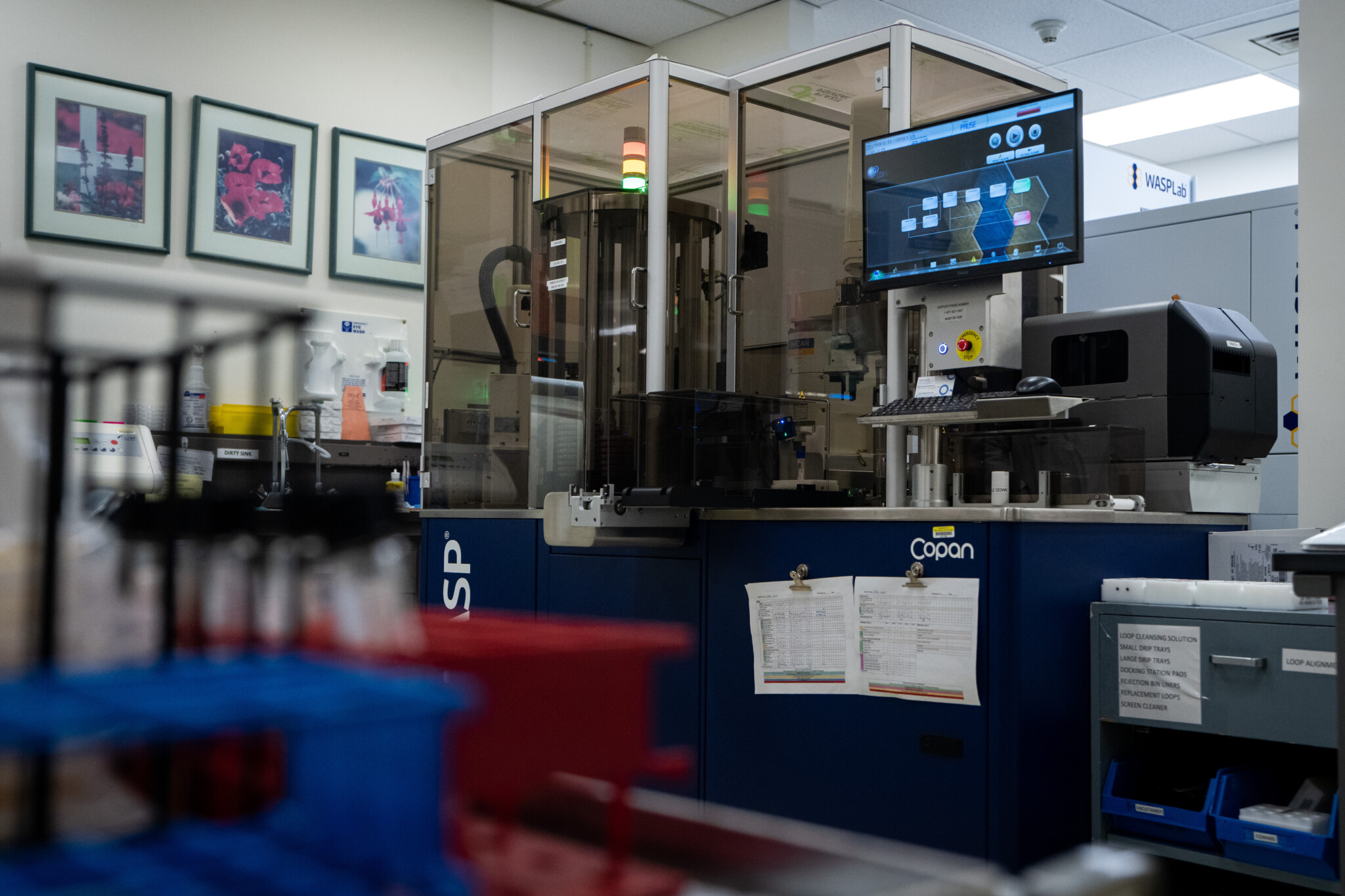DeepDives is a bi-weekly essay series exploring key issues related to the economy. The goal of the series is to provide Hub readers with original analysis of the economic trends and ideas that are shaping this high-stakes moment for Canadian productivity, prosperity, and economic well-being. The series features the writing of leading academics, area experts, and policy practitioners. This particular DeepDive is made possible by RBC and readers like you.
Introduction: A nation caught at a crossroads
Canada stands at a pivotal moment in the age of artificial intelligence. Despite boasting world-class academic talent, a globally respected research ecosystem, and early ambitions to lead in AI, Canadian businesses are faltering in AI adoption. Only 12 percent of Canadian firms have integrated AI into their production or services in 2025, and Canadian businesses have an AI adoption rate below the OECD average. Meanwhile, international competitors are accelerating their AI usage, with the United States, the United Kingdom, and South Korea pushing strategic compute capacity, regulatory clarity, and commercial adoption at scale.
However, the reasons that Canadian businesses are falling behind in the race to adopt AI aren’t primarily technological or talent-driven; they’re cultural, operational, and psychological. A new RBC Thought Leadership report, “Bridging the Imagination Gap,” argues the greatest barrier to AI adoption in Canada isn’t capability, but perception.
In interviews with senior leaders across sectors, RBC has revealed an “imagination gap”: a pervasive inability to envision AI’s strategic relevance or practical benefit. Small to medium-sized companies, especially, often struggle to envision practical, industry-specific AI applications, causing them to underestimate their potential impact on productivity and competitiveness.
To better understand what’s holding us back and how we might push forward, we begin with a hard look at where AI adoption in Canadian business stands.
The state of AI in Canadian business: Promising signals, persistent gaps
Data from Statistics Canada’s most recent surveys, conducted in the last year, reveal both movement and inertia. In Q2 2024, only 6.1 percent of Canadian enterprises reported using AI. Yet by Q2 of 2025, intentions began to shift: 12.2 percent were now using AI to produce goods or deliver services, with 17.9 percent of firms stating they plan to adopt AI software in the coming year, and 6 percent intending to deploy AI-enabled hardware. That’s a nearly threefold increase in software interest year-over-year. However, interest does not equal execution.
AI adoption rates vary significantly across sectors. Leading the charge on planned AI adoption in the upcoming year were Canada’s professional, scientific, and technical services (37.7 percent) and information and cultural industries (37.8 percent), followed by finance and insurance (27.4 percent).
But planned adoption rates drop steeply in manufacturing, retail, and construction, sectors that form the backbone of Canada’s real economy, with less than one-in-five businesses saying that they planned to adopt AI.
This deep barrier may be cognitive. A 2025 KPMG Canada snapshot found that most Canadians don’t trust AI and, more importantly, they don’t understand it. Canada, for instance, is lagging well behind its global peers on AI literacy among employees, with only 24 percent receiving AI education or training.
This apprehension is despite significant benefits. According to a Business Development Bank of Canada study, 97 percent of small and medium enterprises (SMEs) that adopted AI reported “tangible” benefits.
This lack of awareness about the benefits of AI and continued concerns about risks underscores the depth of the imagination gap, highlighting the urgent need for demystification and upskilling.
The benefits are real, and Canada is falling behind its competitors. What we need is to take stock of the challenges companies are experiencing in achieving their full AI-usage potential, while learning from the pioneers who have already broken through AI access barriers.
With that in mind, let’s dive into what barriers Canadian businesses, large and small, are facing, as well as some lessons learned from Canada’s most innovative firms.
Challenge 1: The first-mover dilemma: Risk today, reward tomorrow
AI adoption carries immediate costs—financial, reputational, and operational. Benefits, however, are often deferred and abstract. This is the “first-mover dilemma” at the heart of many stalled initiatives. Canadian technology officers often face 6-to-12-month approval lags due to cost-benefit uncertainty and leadership hesitation. As a result, Canadian divisions of global firms are often less likely to approve AI pilots than their U.S.-based counterparts.
The cost of delay is real. Bell Canada tackled this challenge head-on in 2023 by initiating board-level tutorials and quantifying the opportunity cost of inaction. The result? Rapid funding approvals and real-time speech analytics that now process over 50,000 customer calls daily, transforming client experience and internal workflows. The lesson is clear: framing AI as a business imperative rather than a tech experiment can unlock both capital and momentum.

Minister of Artificial Intelligence and Digital Innovation and Minister responsible for the Federal Economic Development Agency for Southern Ontario Evan Solomon speaks during the Canada 2020 conference in Ottawa on Tuesday, June 10, 2025. Spencer Colby/The Canadian Press.
Challenge 2: AI literacy: The missing middle
Canadian skepticism around AI is both emotional and educational, fueled by low levels of AI literacy. Only one in four Canadians has received AI-related training, resulting in a limited understanding of its capabilities and risks, which in turn slows buy-in and workplace acceptance.
Successful firms have countered this by embedding AI literacy into their team. Hopper, a Montreal-based travel platform, retrained its customer support staff for AI-enhanced roles instead of replacing them. The result: 75 percent faster inquiry handling, resolution times reduced from 20 minutes to under five, and approximately 90 percent cost savings.
Companies like Lumberhub, an online marketplace for businesses looking to purchase lumber, illustrate the power of grassroots innovation. Facing a critical pricing lag, an employee without deep coding expertise leveraged generative AI to build a quoting engine that automated pricing and inventory data integration—a process previously performed manually by telephone. Empowering “super-agents” like this, employees who prompt, patch, and prototype, can turn skepticism into ingenuity.
Challenge 3: The paralysis of plenty: Choosing a starting point
With AI, much can be automated, but not everything should be. RBC’s research shows that larger organizations can become paralyzed by an abundance of potential use cases, struggling to prioritize which AI applications to pursue, thus stalling the implementation of high-value opportunities. Effective internal evaluation processes can help firms prioritize. But execution challenges remain significant.
Three common barriers stall scaling:
- Budget cliffs between pilot funding and operational integration
- Champion churn, where internal advocates leave and take momentum with them
- ROI misalignment, where engineers’ technical wins fail to translate into CFO-level cash flow projections
Bridging the imagination gap requires translating AI benefits into language that decision-makers understand, such as productivity, profitability, and long-term value creation.

St. Paul’s Hospital has installed a new $1 million automated AI-based lab system which uses artificial intelligence and robots for repetitive tasks so humans can do the complex work in Vancouver on Tuesday, January 23, 2024. Ethan Cairns/The Canadian Press.
Challenge 4: The data dilemma: Quality concerns
Before AI can do anything, it must have data to pull from. However, many Canadian firms are struggling with low-quality, fragmented, or siloed data. For SMEs, many of which operate on legacy infrastructure, the burden of integration can be crippling.
Take healthcare. St. Michael’s Hospital in Toronto is a founding member of GEMINI, Canada’s largest hospital data platform. While the platform integrates over 60 percent of Ontario’s hospital data and supports more than 1,000 researchers, it still faces enormous governance and interoperability challenges. Infrequent refresh cycles and format mismatches delay real-time use and compromise potential savings in areas like clinical trials, where automation could cut costs by up to 80 percent.
Without robust, AI-ready data ecosystems, no amount of compute or training will deliver returns. The solution? Investment in national data standards, legacy data modernization incentives, and support for data integration initiatives.
Challenge 5: The blind spot problem: Discovering the unknown unknowns
Much of AI’s value lies not in answering questions we know, but in uncovering ones we didn’t know to ask. Canadian firms often focus narrowly on cost savings or process efficiency, missing AI’s diagnostic and exploratory potential.
Linamar, a Canadian auto parts manufacturer, illustrates the power of discovery. Feeding 10 years of shop-floor data into Acerta’s industrial AI platform revealed slight, unexpected pressure fluctuations that were hampering productivity. Elsewhere, AI identified bottleneck stations slowing down throughput. These were insights that no human alone could detect.
To unlock these unknown unknowns, organizations must formalize “exploration budgets,” which are dedicated resources for open-ended AI inquiry. Treating every dataset as a hunting ground for insight repositions AI from a cost centre to a continuous discovery engine.
Challenge 6: The infrastructure gap: Building Canada’s AI railway
AI innovation requires more than code; it needs power. Literally. Canada trails every other G7 nation in AI compute infrastructure, with approximately one-tenth the per capita capacity of the U.S. This bottleneck can slow iteration speed and disincentivize domestic innovation.
Waiting times in public compute queues can stretch training cycles from hours to days, stalling commercialization. Private cloud services—mainly U.S.-based—fill the gap but may raise sovereignty and security concerns in certain circumstances, for example, sensitive government applications.
The good news: change is coming. Ottawa’s new $2 billion Canadian Sovereign AI Compute Strategy, including the CoreWeave-Cohere partnership, aims to provide Canadian firms with domestic high-performance computing. Alberta’s regional initiatives also offer promise. Still, the clock is ticking. Without rapid deployment and clear incentives, Canada risks losing its competitive edge, not from lack of talent, but lack of infrastructure.
Challenge 7: The regulatory maze: Clarity as catalyst
AI regulation in Canada remains a patchwork. Multiple federal agencies oversee overlapping domains, while provinces like Quebec have passed more stringent laws. The result could eventually be a “mini-EU” compliance landscape—13 provinces and territories, 13 AI regimes.
The federal government’s Artificial Intelligence and Data Act (AIDA) was criticized for a lack of consultation and unclear scope. For SMEs, which lack the legal teams of Bay Street giants, this ambiguity is stifling.
Technology leaders interviewed by RBC emphasized a need for clear guidance from the government, flexible enough to support innovation, yet sufficiently defined to remove ambiguity. What’s missing isn’t stricter regulation, but coherent leadership. Without a national roadmap on AI governance, Canadian firms will continue to underinvest in transformative applications, as they fear future compliance burdens. Regulatory clarity should not constrain innovation—it should catalyze it.
Key takeaways: Bridging ambition and reality
The future of Canadian business competitiveness may hinge on closing the imagination gap around AI. Recent work by RBC offers not just diagnosis but direction. To move forward, Canadian leaders must:
- Quantify the cost of inaction, not just the risk of failure
- Build AI literacy at every organizational level
- Focus experimentation through prioritization
- Invest in data as a strategic asset, not a back-office function
- Create discovery loops that treat AI as a source of insight, not just automation
- Advocate for sovereign compute and clear regulations that empower innovation
Canada has the research. It has the talent. It even has early success stories. What it needs now is belief, the kind of collective conviction that turns technology into transformation. Business, government, and civil society must act in concert, not in silos.
Because in the race to harness AI, imagination isn’t a luxury—it’s a necessity.
This article is made possible by RBC and readers like you. Donate today.










